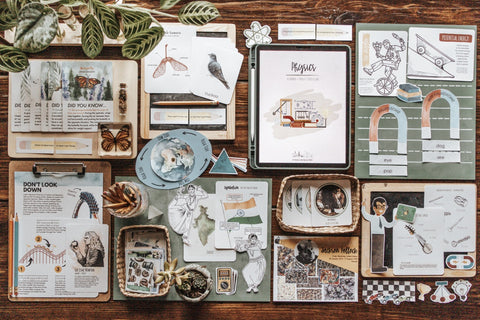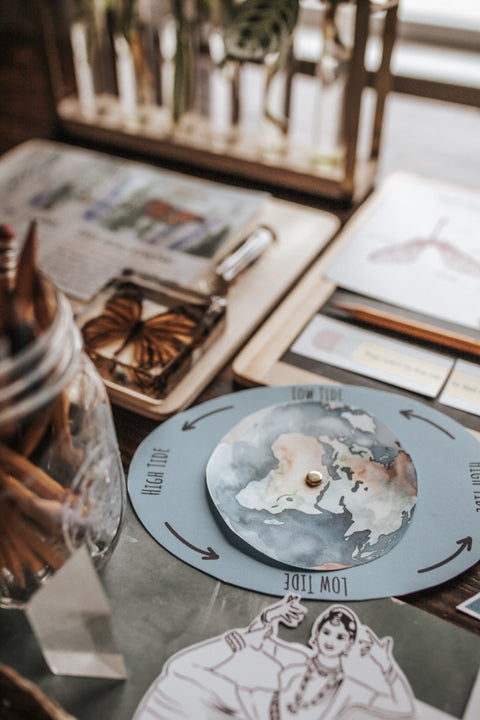Harbor and Sprout
Physics Patchwork Study
Welcome to the Harbor + Sprout Physics Patchwork Study, the February 2024 release of our original elementary-level homeschool unit study curriculum. This unit study features 4 weeks of lesson plans and materials covering all 9 of our core subjects and a playful supplemental section of thematic activities. This unit study is meant for use by children ages 3-12.
This unit is delivered via a secure link as a digital download. Shop corresponding Physics curriculum for all ages here!
CONTENT:
Handbook
Daily, weekly, and monthly planning pages
Book list including stories, poems, and field guides with recommended ages, subject correspondence, and brief summaries for each title
Lesson plans for 4 levels of learning
Family read aloud with discussion guide and recipe
Character kit- new monthly character illustrated by Stephanie Groves to act as your guide through the unit
Science
Week 1: What is Gravity? Physics is a branch of science that studies matter and energy. You see and experience physics every day, from the waves you play in at the beach, to the sunlight coming through your window in the morning, to the gravity that pulls you down after you jump in the air. Explore the earth’s gravitational pull through conducting experiments and research of your own!
Week 2: What are the Laws of Motion? Have you ever wondered what propels a roller coaster forward? If you look closely you’ll notice that they don’t have engines... so how do they move? They rely on the laws of motion, of course!
Week 3: What is Thermal Energy? Learn about thermal energy and how it is produced by building a thermometer, creating an exothermic reaction, investigating heat and harnessing the power of the sun.
Week 4: What is Light Energy? Light energy is a form of radiant energy that is visible to the human eye. Investigate light energy by conducting your own experiments, including creating a solar powered s’mores oven!
Nature Study
Week 1: What is Biomimicry? Do you know what solar cells, underwater glue, and glow sticks all have in common? These inventions were created by people who were inspired by plants or animals and asked the question, “How would nature do it?” This week we will put on our biomimic caps to explore the design process and principles that have led to some of the most amazing innovations throughout time!
Week 2: Lessons From Seeds: This week we’ll discover two amazing inventions modeled from seeds. Grab your magnifying glass, it is time to explore!
Week 3: Lessons From Arthropods: Arthropods are some of the toughest creatures on the planet! Their remarkable adaptations have inspired the most amazing inventions, from water harvesting technologies modeled after desert beetles, to energy-efficient lighting based on fireflies.
Week 4: Lessons From Birds: With their unique feathers and breathtaking arial displays, birds have inspired us to learn how to fly, build stronger, more flexible bridges, and move silently across the land. There’s so much to learn from our winged friends. Have your train ticket ready! Our first stop this week takes us to Japan.
Language Arts
Week 1: Physics Words: Grow your vocabulary by studying the -ight word family. Familiarize yourself with words commonly used in physics & learn their origins. Practice spelling with a lightbulb spelling activity, and practice your writing by tracing the quote by the famous physicist Albert Einstein.
Week 2: My Shadow: My Shadow” is a playful children’s poem written by the Scottish author and poet Robert Louis Stevenson (1850-1894), who is famous for writing the books “Treasure Island” and “The Strange Case of Dr. Jekyll and Mr. Hyde.” Stevenson’s poem is about a shadow. What is a shadow? Have you ever noticed your shadow? How would you describe it?
Week 3: Infinitives: An infinitive is a type of verb (called a verbal) that is formed by adding the word “to” to the base form of the verb. In this lesson, we will learn how to identify and use infinitives in writing.
Week 4: Palindromes: The word “radar” can be read in either direction (forward or backward), and it still says radar! Give it a try. It’s a palindrome!
Writing
Week 1: Goal Setting: Setting goals is an important part of life. Do you want to get better at something? Is there a career that you want to do when you grow up? The point of setting a goal is so that you have something to aim for. You can direct your energy and efforts toward achieving your dreams!
Week 2: Journal Writing: A journal is an account of your personal thoughts. Writing in a journal is a great way to practice writing. It is also many additional benefits including: Boosting self esteem, helping achieve goals, and reducing stress.
Week 3: Create a Slideshow: This week you get to create your very own slideshow presentation. This will give you practice gathering information and presenting it to someone else. There are many times in life that you will need to share information with other people. Learning to do this in an organized way is important.
Week 4: Creative Writing: The best way to improve your creative writing skills is to practice, practice, practice. Creative writing means that you make up a new story, one that has never been told before. Your goal this week will be to write at least one story every day.
History
Week 1: Archimedes and His Principle: Archimedes was born in a Greek city-state known as Syracuse, Sicily around 287 BCE. He used mathematics and his understanding of the world around him to solve problems. He was a scientist who studied matter and the forces that acted upon it, then used his observations to invent machines to solve everyday problems.
Week 2: Galileo and the Law of Inertia: Galileo is quite famous for his telescope and his discoveries in outer space, and he also conducted many experiments in the field of physics including studying gravity, pendulums, inertia, flotation, and more. He even invented a device to measure temperature called a thermometer!
Week 3: Newton and the Laws of Motion: Above all of his other discoveries and inventions, Isaac Newton is most famous for three laws of physics that he discovered which today we call the Laws of Motion. These laws, or truths, about how objects and forces work together help us understand how motion works in our world.
Week 4: Tesla and Electricity: Not to be confused with the popular car brand of today, Nikola Tesla was a physicist who was very interested in electricity. He studied it, conducted experiments, and, in 1882, he discovered a way to harness the type of electricity we still use today.
Geography
Week 1: India: Learn about the country known for its spicy food, vibrant clothing, and breathtaking architecture as seen in the Taj Mahal and the Lotus Temple.
Week 2: Maps: Trace and color a map of India. Locate India & Asia on a world map. Cut and paste land features onto a map of India. Test your knowledge by filling in a blank map of India from memory!
Week 3: Indian Culture: Immerse yourself into rich Indian culture by studying Indian language, religion, cuisine, and dance.
Week 4: Geophysics and Aryabhata: Born in the year 476 AD, Aryabhata was a major Indian mathematician, astronomer, and physicist. He is credited for the discovery of theories like our solar system rotation, approximation of pi, trigonometry, the place value system, and the number zero. His discoveries and theories influenced and inspired many other scientists in the future.
Music
Week 1: What is Sound: Have you ever wondered what exactly is sound? Or how your ear is able to hear it? This week we will explore these questions and more!
Week 2: Sound Frequency and Amplitude: Why do some instruments make a higher pitch sound while others make a lower pitch sound? Do sound waves from high pitch sounds and low pitch sounds look different? Does a louder sound wave look different than a quiet wound wave? These are the questions we will be exploring this week!
Week 3: Acoustical Engineering: We have learned a lot about sound waves so far in our lessons! This week we will explore a particular branch of physics that studies sound waves.
Week 4: Instruments of India: Learn about instruments played in India; the Sarod, the Dholak, and the Pungi.
Art
Week 1: Motion: Discover artwork by the artist Jackson Pollock. Explore the art element of Space, and create your choice of motion inspired art projects.
Week 2: Energy: Learn about and create art filled with color, inspired by the works of Dale Chihuly.
Week 3: Light Optics: Study the art form of color and create projects inspired by light and optics.
Week 4: Sound: Discover artwork created by the artist Melissa McCracken, an artist with a special gift: synesthesia. This is when your brain mixes things up and sensory experiences can be had with multiple senses at once. In Melissa’s case, this means she has sound and vision mixing together, which is where she gets the inspiration for her paintings!
Math
Week 1: Bird Speed Research Project: Use the flashcards provided to research the average flying or swimming speed of different birds. Then, arrange them from the fastest to the slowest.
Week 2: Transport Vehicle Speed Word Problems: Practice mathematical operations by solving word problems involving transport vehicles.
Week 3: Vehicle Place Value: Partition numbers into the appropriate place value.
Week 4: Roll and Race to 100: Race your car from 1 to 100 on a numbered grid by rolling a dice. The first player to reach 100 wins!
Supplement
- Physics Coloring Pages
- Draw The Other Half Activity
- P is for Physics Writing
- Physics Math Loose Parts Cards
- Physics Memory Match
- Physics 4-Piece Picture Puzzles
- Physics Silhouette Match
- Physics Fact Cards
- Physics Spelling Puzzles
- Physics Matching Facts Card Game
- Physics Word Search
This unit is delivered as a downloadable zip file. H+S Patchwork Studies average approximately 550-650 pages of content. While the download does include the option to print the full unit straight through front and back, we recommend printing on an as-needed, as-you-go basis. Enjoy your Physics adventures!






















